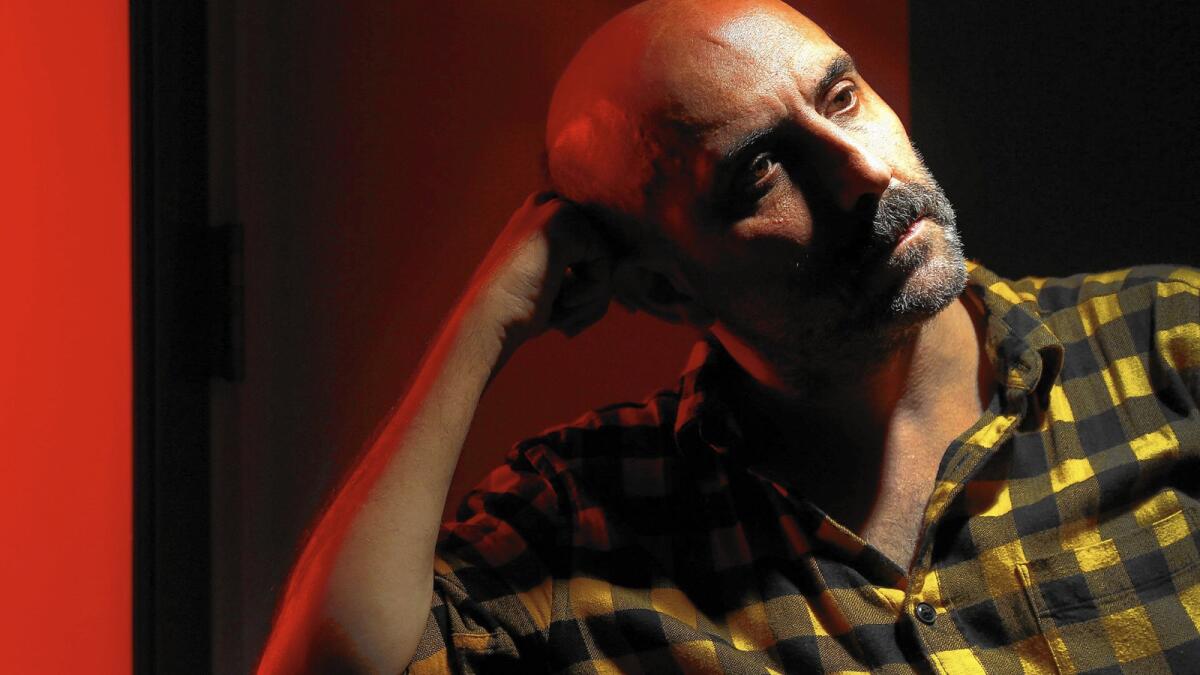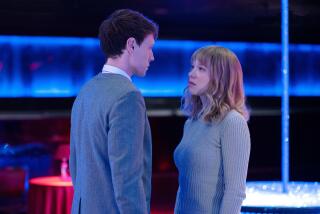Q&A: Filmmaker Gaspar Noé talks ‘Love,’ sex and his 3-D vision

Director Gaspar Noe
Born in Argentina but long based in France, filmmaker Gaspar Noé has something of the ageless bad boy about him, a maker of films designed to surprise and provoke. He gained notoriety for his 2002 feature “Irreversible,” which featured a complex timeline, bracing performances by Monica Bellucci and Vincent Cassel and one of the most brutal rape scenes ever filmed. He followed that up with 2009’s hallucinatory “Enter the Void,” a dazzling, drug-drenched experiment in cinematic point-of-view.
SIGN UP for the free Indie Focus movies newsletter >>
So when word circulated that his new project would be a sexually explicit film in 3-D called “Love,” audiences prepared themselves for something extreme. Noé upended those expectations by making a film of melancholy sadness in which the 3-D effects create a tableau-like immersion.
In the film Murphy (Karl Glusman) is dissatisfied with his new life as partner to Omi (Klara Kristin) and father of their young child. When he learns that Electra (Aomi Muyock), the woman he was with before Omi, has gone missing, he reflects back on their relationship.
Recently other films such as “Blue Is the Warmest Color” or “Nymphomaniac” have also portrayed scenes of explicit sex, with some confusion over what is real and what is simulated. What is the draw for filmmakers to portray explicit sex, is there some elemental connection between sex and cinema?
I would say that falling in love is the most natural thing in the world. Everybody has been through it, everybody has scars, everybody wants to restart falling in love. I think it’s more normal to make a movie dealing with love, sexual or not, than to make movies about bank robberies, which very rarely happen in real life. So I would say the problem is not what some people feel is normal, I would say the problem is why this whole industry is far more obsessed with filming scenes of dominance, guns, invasion.
Was the film difficult to cast?
It was a long process. Initially I thought finding a real couple would be easier, but that did not happen. I cast it in England, in Canada, in the States, and I was also trying to find some English-speaking actors in France. Toward the end of the casting process I met Karl and thought he was the coolest one, the funniest one. And then Aomi I meet one year earlier, and initially she did not want to be a part of the movie, but we still became close friends and then she changed her mind. She ended up trusting me, meeting Karl. Also, the good thing about this movie is all the people I proposed to be on-screen knew my previous movies and knew we were doing something valuable, a real movie about a real subject and not something dirty.
What do you mean?
It’s not like I was doing a B-movie or an erotic movie. I was doing a serious movie about a very relatable subject, that is, a love addiction. The movie is called “Love,” but it’s mostly about passion, how you experience it the first time you fall in love, you think that is going to be your whole life project, loving someone. It burns your brain, you kind of become blind, the moment you see the person you’re in love with you want to see that person again and again and again, kiss that person, hug that person. You turn blank to the rest of the world.
The presence of this person makes you release all kinds of substances in your brain, serotonins and endorphins. The moment you break up with that same person, you feel like a junkie who is not getting the drug anymore. Many times I’ve heard people say, “I’m in love with falling in love.” You get all the best and all the worst in the same place.
Why did you want to make the movie in 3-D?
My favorite use of 3-D in the history of cinema is “Gravity.” I saw those fluid, long moving takes, and it was eye-blowing. Also, I really like watching the 3-D-enhanced version of “The Wizard of Oz,” because at that time the shots would be much longer than in a movie nowadays, so it looks like a real puppet theater. When it comes to that movie that’s all about illusion, there was something even dreamier in the fact it’s in 3-D. This movie is wanting to portray the intimacy of a couple.
I would say the 3-D creates an effect of higher reality, it’s both more real and more surreal. It looks more like life, but it’s not real life. It creates some weirdness. Even when you put the glasses on as a spectator, you go sit in the audience, you put the glasses on and you pay less attention to the people around you. It’s like spying on someone else’s life but not just from one keyhole.
When the film was first announced, the idea of Gaspar Noé making an explicit 3-D movie called “Love” seemed like a provocation all by itself. How aware were you of that?
There have been many directors who because of their work are attached to a particular kind of show or trip or shenanigans. All my friends are obsessed with Dario Argento, he’s a funny guy who makes these colorful horror movies. Or Hitchcock, he became such a persona he put himself on every poster. John Waters is also someone who is known for being John Waters. When I hear of Todd Solondz, whose movies I absolutely love, I think of him and his interviews. Harmony Korine is another.
I guess what’s strange about my movies, the two previous ones were either very druggy or very violent. So when this one, that’s a melancholy movie, was announced, people thought it would be like “Caligula” or something really dark, a dark vision of sex. But it’s totally the opposite. I don’t know what people were expecting when we showed at midnight at Cannes, but for sure it was not exactly what it was. If someone told me the director of “Cannibal Holocaust” was doing a sentimental movie you maybe wouldn’t believe it even if he’s the sweetest person.
Follow me on Twitter @IndieFocus
More to Read
Only good movies
Get the Indie Focus newsletter, Mark Olsen's weekly guide to the world of cinema.
You may occasionally receive promotional content from the Los Angeles Times.







